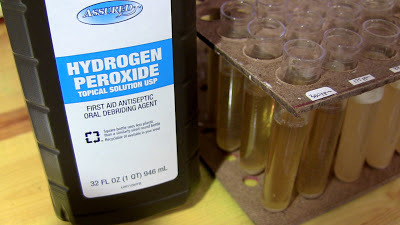How does hydrogen peroxide kill toxins in a cell? How can one decrease hydrogen peroxide levels in the body? Is hydrogen peroxide a medical “miracle”? Now, researchers at Wake Forest University School of Medicine have solved how part of this complex process works.
Namely, the pancreatic enzymes effectively break down the thick protein covering the affected cells, so the immune system does not recognize them as cancerous.
In its pure form, it is a very pale blue, clear liqui slightly more viscous than water. However, it is also stored inside cells , in such a manner that it does not destroy the cell itself. Have you ever read the ingredients listed on a bottle of household disinfectant, chlorine-free beach,. Most biological sources of hydrogen peroxide involve the spontaneous or catalytic breakdown of superoxide anions (O 2−), produced by the partial reduction of oxygen during aerobic respiration and following the exposure of cells to a variety of physical, chemical, and biological agents (Figure 1). The most overlooked solution to all manner of illness and disease is perhaps the simplest.
All pathogens, viruses, and parasites are anaerobic. They thrive in the absence of oxygen, but cannot survive with an abundance of oxygen.
Even cancer cells cannot exist in oxygen. An excessive production of oxygen metabolites such as H2Oleads to oxidative stress and disease. When you dab hydrogen peroxide on a cut, that white, fizzling foam is actually a sign that that the solution is killing bacteria as well as healthy cells.
Conclusions and Perspectives. Increased levels of hydrogen peroxide in cells can result in oxidative stress and cause cellular damage. Indee such damage is associated with the initiation and progression of many diseases, including neurodegenerative disorders, diabetes, atherosclerosis, and cancer. Peroxides are oxidizing agents, which means they work by pulling electrons from other molecules in the cells. This is very important.
In the fuel cells, hydrogen peroxide serves two roles: it is a catholyte, meaning it is both the electrolyte – a liquid that conducts electricity and allows the reaction to occur – and it is the cathode, or the portion of the battery that attracts electrons. Low oxygen levels can cause cancer, and some people think that exposing cancer cells to high levels of oxygen will prevent them from growing and they will die. Blood platelets release hydrogen peroxide on encountering particulates in blood. In the large intestine, acidophilus lactobacillus produces H2Owhich keeps the ubiquitous candida yeast from multiplying out of control. It is a strong oxidizer and can be used as a cleaning agent and to prevent infections.
When used topically, this antiseptic foams due to the enzyme catalase. As the catalase comes in contact with the skin it turns the hydrogen peroxide into water and oxygen gas.
Slime layer is a protective biofilm around the bacterial cell wall. Ten minutes of hydrogen gel application in the gums and periodontal pockets helps to destroy almost all the bacterial cells by breaking their cell wall. The chemical is hydrogen peroxide (H2O2), the active ingredient in color safe bleach.
Produced in all animal cells , hydrogen peroxide may act as a signal for the active and resting phases of living things, new research by USC biologists suggests. Oxygen is a double-edged sword. We can’t live without it, but it also hastens our demise by playing a role in the aging process. The mechanism of the so called “redox signaling” includes the H2O2-mediated reversible oxidation of redox sensitive cysteine residues in enzymes and transcription factors thereby altering their activities. Many have observed whitening on the tips of fingers exposed to the chemical for a long perio this is because hydrogen peroxide is absorbed into the skin, where it can create a skin capillary embolism.
Over-application or the use of a high-concentration form of the chemical can damage skin cells , leading to chemical burns and blistering. It helps maintain the pH balance of the skin and clean your lungs and ears. It also helps to soften the skin layer. I have used hydrogen peroxide for skin cancers – mostly basil cells I believe, but perhaps for the more serious types, Squamous cell or even melanoma, as well.
Hydrogen Peroxide for cracked heels. I really don’t know for sure. Without question though some of the growths on my chest and on my face and on the side of my jaw bone went very deep and took many days of deep digging.
Herein we described that hydrogen peroxide has several effects on lung cancer cells including DNA damage, cell cycle arrest, apoptosis, migration, and inflammation.

No comments:
Post a Comment
Note: Only a member of this blog may post a comment.